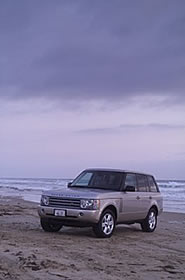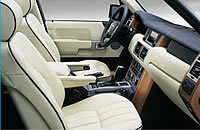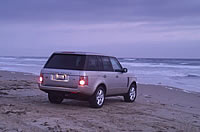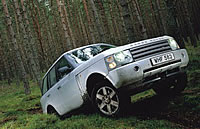 Who
would have thought that the issue of these two car cultures would have turned
out so well? We speak of the German (or more specifically the Bavarian) and the
British automotive traditions. Who
would have thought that the issue of these two car cultures would have turned
out so well? We speak of the German (or more specifically the Bavarian) and the
British automotive traditions.
An
odd, and short-lived, union began with BMW's acquisition of a handful of British
marques a number of years ago. From that congress came the delightful MINI and
MINI Cooper S, the only offspring still under the BMW roof. When
BMW decided it wanted out of its precipitous plunge into matrimony the custody
of Land Rover migrated to Ford, along with Wolfgang Reitzle who had been chief
of BMW's product development. He continued looking after the Range Rover at his
new address.
Out
of all these convoluted and sometimes fleeting relationships (Reitzle is himself
no longer with Ford) we nonetheless have the happy circumstance of Land Rover's
new 2003 Range Rover.
It's
a fine, lusty and handsome specimen.
This
is the third major redesign of the Range Rover in its some 30-year history. The
2003 version is wider, taller, longer, heavier, higher off the ground, more powerful
and more expensive than its predecessor. It also is far better mannered on the
highway, roomier, better-looking, more comfortable and more replete with technological
and safety features (there are no fewer than eight airbags in the new model.)
In
brief, the 2003 Range Rover is a dazzler. And quite likeable in the process. Though
it lives large it drives small. Goldilocks would have found it just right.
The
first thing the German input did at Rover was straighten the rather wobbly quality
control that had befallen the British industry. (Ford had brought much the same
reforms to Jaguar.)
Then came the total makeover of the Range Rover. The new
influence is immediately evident in some of the de-quirking of the controls. But
perhaps fortunately BMW did not have the time nor will to indulge its penchant
for over engineering that can be downright obfuscating at times. You'll find nothing
like BMWs befuddling iDrive in the Range Rover. Everything is in ordered rows
with clear dials and generally intuitive controls.
 A
legacy of the new BMW 7 Series is pleasantly present in the smart interior. Executives
familiar with corner offices, fine ocean-going yachts, limited edition watches
and furniture with designer names attached will feel instantly in their element
in the Range Rover. There's the sculptural wood trim that invites a hand, the
brushed aluminum and the touches of bright work all making for the sort of elegance
that is cool and warm at the same time. The seats are both comfortable and supportive
and fitting for both off-road upheavals and Interstate blandness. A
legacy of the new BMW 7 Series is pleasantly present in the smart interior. Executives
familiar with corner offices, fine ocean-going yachts, limited edition watches
and furniture with designer names attached will feel instantly in their element
in the Range Rover. There's the sculptural wood trim that invites a hand, the
brushed aluminum and the touches of bright work all making for the sort of elegance
that is cool and warm at the same time. The seats are both comfortable and supportive
and fitting for both off-road upheavals and Interstate blandness.
The
Range Rover with its excellent full-time four-wheel-drive system has always been
noted for its aplomb on seriously bad roads and on no roads at all. Perhaps only
the Mercedes-Benz G-Wagen (now called the G-Class) with its three locking differentials
could out do it off-road. This new Range Rover may well be a match. It certainly
bests the G-Class in elegance and smooth design. The G-Class still cannot quite
conceal its military origins in its stiff civilian clothes and utilitarian demeanor.
The
Range Rover's road clearance has been increased by 2.6 inches to an impressive
11 inches. That's one of three riding heights. The vehicle automatically lowers
its stance at highway speeds and an "Access" height (1.5 inches lower)
can be selected to make getting in and out easier.
Probably
the most remarkable change in the Range Rover is its ability to eat up the Interstate
without any hint of its being an SUV. Bring on the lo-o-ong treks. It will not
rival a grand touring car on the twisty bits but its new independent suspension
and greatly increased rigidity (250%) improve its road handling characteristics
considerably. (Something I'd like to see down the pike: use of the Lincoln Navigator's
precise new steering system. It's all in the family now.)
 Ford,
Land Rover's corporate parent, finds itself in the interesting position of selling
a British car with a German engine. This is the BMW 4.4 liter V8 with 282 horsepower
at 5400 rpm (up by 62 over the old Range Rover) and 325 foot pounds of torque
at 3600 rpm. Though this bigger vehicle totes 500 more pounds that the previous
one it can accelerate from a stop to 60 mph in under 10 seconds. The old one could
not. Ford,
Land Rover's corporate parent, finds itself in the interesting position of selling
a British car with a German engine. This is the BMW 4.4 liter V8 with 282 horsepower
at 5400 rpm (up by 62 over the old Range Rover) and 325 foot pounds of torque
at 3600 rpm. Though this bigger vehicle totes 500 more pounds that the previous
one it can accelerate from a stop to 60 mph in under 10 seconds. The old one could
not.
Will
future Range Rovers see the supercharged Jaguar engine? Silly. No one talks future
at new vehicle introductions.
Range
Rover has long sniffed at differential locks but now has a locking center differential.
The smooth-shifting five-speed automatic gearbox is quick to respond on the road
and easy to use in rough conditions. Shifting between high and low range can now
be done while underway at speeds up to 30 mph. In low range at 1000 rpm the vehicle
will walk smoothly along at 2.4 mph, a segment-best creeper in my experience.
A
driver might look forward to testing such a granny gear on steep hill descents
but technology has thrown in another assist for that. Drop the Range Rover's neat
nose over a near precipice. As the all-sky view sweeps to the depths below simply
keep your feet away from the pedals and ride it out. With groaning and creaking
worthy of a Harry Potter soundtrack, an abler-than-thou system known as HDC (Hill
Descent Control) alternately brakes and frees the individual wheels to keep the
vehicle heading down the fall line totally under control.
I
am of mixed emotions about this feature - in awe because it works so well but
a little miffed because it won’t trust me to try it on my own. Getting down
the treacherous steeps safely is satisfying, yes, but feeling as if you as driver
had some part in accomplishing that end can be elating. HDC turns driver to passenger.
 But
that is what technology is doing these days. A soup can of letters - HDC, ABS,
EBD, DSC - makes us all better drivers than we might really be. But
that is what technology is doing these days. A soup can of letters - HDC, ABS,
EBD, DSC - makes us all better drivers than we might really be.
You've
seen HDC and its efficacy on steep descent. You know about ABS (anti-lock brakes,
in this case of four discs). In the Range Rover ABS is enhanced by electronic
brake assist, which makes sure that braking power is retained even if the driver
has slacked off the initial effort.
EBD
(Electronic Brake force Distribution) maintains an optimum balance between rear
and front wheel braking.
DSC
(Dynamic Stability Control) is Ford's system that uses a timely application of
braking and restoring power to individual wheels to keep a vehicle from swapping
ends even if overdriven. Some similar systems come into evidence so early a lot
of the fun of driving is tempered. Not here. This just holds your course for you
(say while maneuvering on icy roads), quashes fish-tailing and keeps you from
looking really stupid.
The
traction control system, which is used by DSC in maintaining directional stability,
has a side benefit important to off-roading; it diminishes wheel spin and lessens
damage to the surface.
Although
serious off-roaders were distressed to learn that Range Rover had gone to independent
suspension - important to the on-road ride but usually deleterious to off-road
operation - were surprised and pleased to discover the change had no ill-effects.
This thanks to the extreme new monocoque body stiffness and the ingenious new
Crosslink air suspension. Constant monitoring of wheel position can send leveling
instructions back and forth from right to left wheel. Whatever it does it smooths
the rugged off road and assists the Range Rover in conquering some tough terrain.
The
new Range Rover is a five-place vehicle. The rage for third-row seating did not
flare up until it was well into development. Perhaps later. |